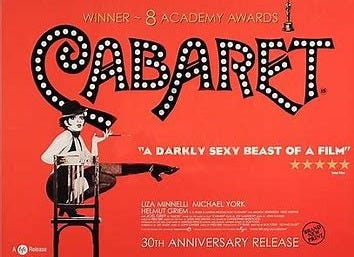When people think of Cabaret the musical, they often remember the sultry songs, the sexy costumes, and the dark glamor of the Kit Kat Club. It's a musical filled with laughter, love affairs, jazz hands, and lots of eyeliner. But here’s the thing, Cabaret isn’t just a show about entertainment. It’s a show about distraction.
This musical is about what happens when people look the other way while the world quietly burns.
The Story Beneath the Sparkle
Set in 1931 Berlin, Cabaret drops us into a city on the edge of collapse. Outside the club, fascism is rising. Inside the club, the Emcee invites you to forget all that: “Leave your troubles outside!” And that’s the central conflict. Between illusion and reality, and how people choose comfort over confrontation.
Sally Bowles, the very optimistic nightclub singer, “doesn’t want to talk politics.” She wants love, parties, champagne. And maybe we do too, you know, as the audience? But just for a while. However, the world doesn’t pause because we don’t want to deal with it. And Cabaret shows how ignoring the real world doesn’t save anyone.
Costumes That Tell the Truth
Here’s where the visual storytelling gets so brilliant!
1. Clothes Falling Apart
In most modern productions, especially since the 1998 revival, the dancers' costumes are frayed, ripped, or just slightly off. They are sexy, but also worn-out. The lace is torn, the fishnets have holes, and the boots are scuffed.
Why?
Because it’s a club! And… a city barely holding itself together.
Behind the laughter and seduction is poverty. The Kit Kat Club isn’t just a setting, it’s a metaphor for pretending everything’s fine while everything is clearly falling apart. It’s unique how thoughtfully the costumes are designed to depict this!
2. Sally’s Glamour Is a Lie
Sally Bowles, the female lead, is often dressed like a star—but a cheap one. In many productions, she wears mismatched lingerie, ill-fitting dresses, or things that look thrown together in a hurry. It’s all deliberately…theatrical. This is because Sally is performing for the world. She needs the illusion that she is dazzling!
But underneath that glitter is someone who is absolutely terrified of being ordinary, irrelevant, or even worse…forgotten. Sally’s makeup is sometimes too bright. Her voice a little shaky. The costume tells you the truth that Sally won’t say out loud: she’s trying hard to look like she belongs in a fantasy, but it’s slipping.
Hair and Makeup as Symbolism
Makeup in Cabaret isn’t just about style—it’s about survival.
1. The Emcee’s Face: A Mask for Society
The Emcee often wears heavy, strange, or exaggerated makeup. Sometimes it’s beautiful. Sometimes it’s grotesque. It changes from production to production, but it always walks the line between entertainer and monster.
That’s because the Emcee represents the world’s willful blindness. He’s the ultimate distraction. But as the story darkens, his appearance often gets more distorted, less charming, like a mask that’s starting to melt.
2. The Dancers Sexualization
The Kit Kat Girls (and Boys) might seem like background characters, but you need to watch more closely. They’re often styled to look tired and overworked. Smudged eyeliner, limp curls, and forced smiles tell a quiet story. They're not just here for fun. They’re surviving.
That’s the genius of Cabaret: it hides tragedy in plain sight.
The Design Is the Message
Even the stage design in Cabaret plays a role in its meaning.
Mirrors are often used in productions, reflecting the audience back at themselves. It’s not just a visual trick, it’s a reminder: This isn’t just about 1930s Germany. It’s about you. Right now. I often refer to a famous quote by Mark Twain when I think of Cabaret:
"History doesn't repeat itself, but it often rhymes."
And then there’s the ending, one of the most devastating images in modern musical theatre. In some productions, the Emcee removes his flamboyant costume and opens his coat to reveal a concentration camp uniform, complete with the yellow Star of David and the pink triangle, marking him as both Jewish and queer.
After a show spent entertaining the audience, he is finally stripped of all performance—no makeup, no glitter, no smirk—just a victim of the regime he pretended wasn’t real. This final image forces us to confront the cost of denial. It’s not just metaphor anymore. It’s history. It’s human. It’s a reminder that the people who seem untouchable in the spotlight are often the first to disappear when the lights go out.
To Wrap it Up
At its core, Cabaret is about what happens when people choose comfort over reality. It’s about how governments rise, rights disappear, and cruelty becomes normalized, not all at once, but slowly, while everyone’s busy looking the other way.
It’s also about how performance can be a shield, and how we sometimes use art, parties, or even love to avoid facing the truth.
Every song, every sequin, every crooked curl on a dancer’s head is part of that story. And when the curtain falls, Cabaret doesn’t let you go with a neat, happy ending. Instead, it leaves you sitting in the dark, asking:
What am I ignoring right now?
And what will it cost me?
Because beneath the jazz hands, it’s not a story about escaping reality.
It’s a warning about what happens when we do.





This was absolutely amazing. I really love how you broke down the clothes falling apart to the hair/makeup then the dancers sexualization and really tied all those aspects today to the central message of Cabaret. It was brilliant and easy to understand.
What a wonderful analogy about cabaret! I enjoyed how you broke it down into well-thought-out sections. It made everything so much easier to understand!